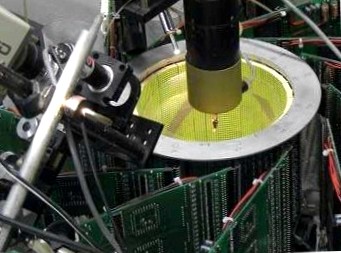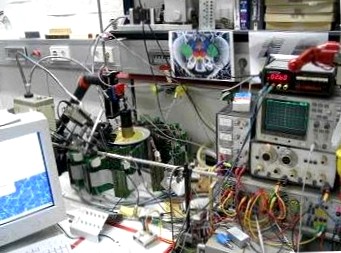Memories of a fruit fly studied in the laboratory
The fruit fly can recognize patterns and remember them. Neuroscientists at the University of Wurzburg have now discovered where this process takes place in the brain and which nerve cells are involved in it.
Drosophila melanogaster has a visual memory. It recognizes patterns and can remember them by analyzing them on the basis of five different parameters. Like humans, fruit flies are able to recognize optical impressions even if they appear in a completely different place in the field of vision. Using genetically modified fruit fly strains, researchers at the Biocenter in Wurzburg, Germany, have now discovered the neuron groups involved in remembering two of these parameters. In the current ie of Nature (Vol. 439, no. 7076 from 2.2.2006) they report.
No memory without Rutabaga gene
Neuroscientists already have a pretty good understanding of how individual neurons function and how they communicate with their immediate environment. At the next higher level of organization, however, there are still many questions: Which neurons form functional networks, how do they encode behavior, and how does experience change the activity and connections in these networks so that behavior changes?. To investigate such questions, Drosophila is ideally suited because this organism is now very well known and controllable.
Drosophila in the flight simulator. You can see how the fly is held in a clamp by means of a small wire bail glued to the back of the head and thorax (jerk) of the fly, which is then attached to the torque measuring device.
It has been known for more than 100 years that insects can see patterns. In the early 1980s, several genes responsible for synaptic plasticity and learning were discovered in fruit flies. One of them is the rutabaga gene. Martin Heisenberg and his group from the Biocenter of the University of Wurzburg, together with colleagues in Beijing, have now conducted experiments on the localization of pattern memory.
We bred a species of flies that could learn almost nothing because their rutabaga gene was switched off. With their help we wanted to find out where the memory trace for the visual pattern learning of the fly is located. The question to be answered was: "Where must the missing enzyme of the rutabaga gene be made available in the brain so that the fly can remember patterns again??"
In their experiments, the researchers benefited from one thing: Drosophila is a creature that possesses transposons, jumping genes that can change their location in the genome and transport other genes in the process (so-called. Transgenes). In this way, they were able to reactivate the rutabaga enzyme in different brain regions of the flies and eventually find out in which brain cells the rutabaga enzyme is needed for the visual memory process. To measure memory for patterns, they love to fly Drosophila in a flight simulator.
Artificial panorama
The flight simulator is computer controlled and consists of a cylindrical drum, the wall of which is equipped with a display. Panoramas with various patterns can be created and moved on it. The fly hangs in this drum, fixed to a dark wire and connected to a sensor that detects and feeds into the computer the rotational forces that the fly generates with its wings. It calculates in real time how the fly had turned in free flight at the same manover – and then shifts the artificial environment around the fly by exactly that amount. The insect gets the visual impression that it has actually changed direction. "The fly thinks what it sees is what it recognizes, by the way it flies. She takes the situation seriously," says Heisenberg.

The fly flies at the torque measuring device in the center of an artificial 360° panorama (green LEDs), in which it can determine its own flight direction in relation to different visual patterns (here: differently angled bars).
To train the fly on visual impressions, different patterns are shown on the display. When it flies towards a certain pattern, it is heated by the laser beam. Because it is not comfortable with this, it changes the direction of its flight. So it quickly learns what it has to do to avoid being heated and it keeps this even when the laser beam is switched off.
As Heisenberg’s group found out in earlier experiments, the interesting thing is that the fruit fly does not store its environment photographically in its memory, but according to certain characteristics. Researchers have identified five so far: the center of gravity of the pattern, the slope of edges (edge orientation), the coarseness, the vertical density distribution, and the color. Fruit flies memorize visual impressions by analyzing them based on these parameters and storing their values. Thus, they are able to recognize patterns even if they appear later in another place. Scientifically this is called translation invariance.

The flight simulator with the corresponding electronics.
In their current experiments, Heisenberg and colleagues presented only patterns that differed in either height or edge orientation. This selection led to different responses and thus to the locations in the brain responsible for the recognition of these two parameters: one neuron group each in the fan-shaped body of the central complex.
"We can find out the location of visual memory only for these two parameters at the moment, but the principle has become clear," Heisenberg comments the result. "With this, we are already much further along. Moreover, these two types of cells form two layers in a part of the brain that one is just beginning to understand what it is good for. It is the first time that a behavioral experiment on pattern vision has revealed something about the nerve networks involved in it. This is the most important finding."